Diana Botutihe was born at sea. She has spent her entire life — 50 odd years — living on boats that are typically just five metres long and one-and-a-half metres wide. She visits land only to trade fish for staples like rice and water, and her boat is filled with the accoutrements of everyday living — jerry cans, blackened stockpots, plastic utensils, a kerosene lamp, and even a couple of pot plants.
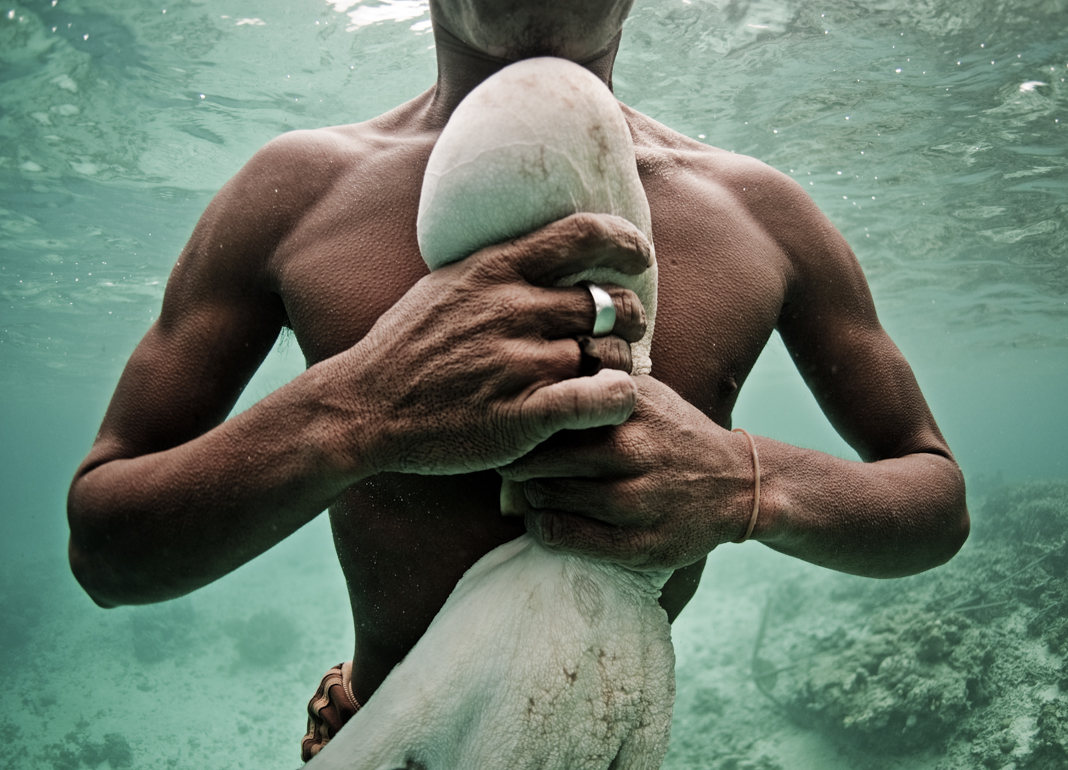

Photo: James Morgan
Last of the Sea Nomads
Diana is one of the world’s last true marine nomads — a member of the Bajau ethnic group, a Malay people who have lived at sea for centuries, plying a tract of ocean between the Philippines, Malaysia, and Indonesia.

Ibu Diana Botutihe is one of the few remaining people in the world to have lived her entire life at sea, visiting land only intermittently and as a matter of necessity in order to trade fish for rice, water, and other staples. Here she is pictured on her boat in Sulawesi, Indonesia.
All photos courtesy of James Morgan. Find him on Facebook and Twitter.
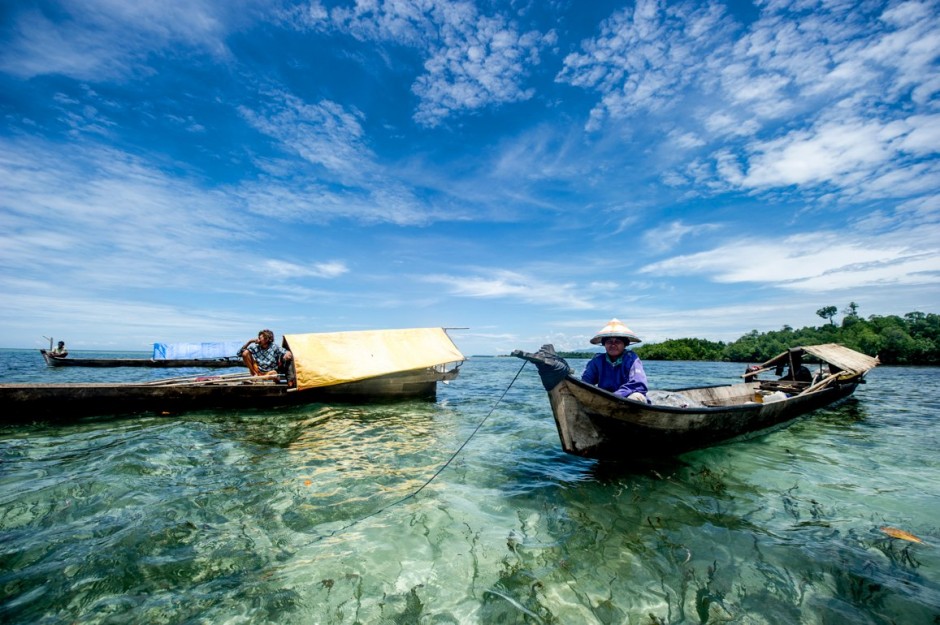
A collection of traditional, handmade Bajau lepa lepa boats off the coast of Pulau Bangko. More and more Bajau are abandoning their traditional nomadic lifestyle to settle in permanent homes in stilt villages, but a dwindling few still choose to live the majority of their lives at sea.
Photo: James Morgan
When I first set out with photographer James Morgan in search of the nomadic Bajau, we weren’t even sure they still existed. Over the last few decades, controversial government programmes have forced most of them to settle on land, or in stilt villages at the water’s edge. We knew of settled communities in the volatile islands of the southern Philippines, around the popular resort area of Semporna in Malaysian Borneo, and further south on the Indonesian island of Sulawesi. And then a friend in Bali told us of a stilt village called Torosiaje in North Sulawesi, which immediately caught our imagination.
Unlike its many counterparts, Torosiaje lies a full kilometre out to sea, in the newly formed Gorontalo province of northern Sulawesi. It took us two flights from Bali, the second on a rickety twin-engined Fokker, and a seven-hour bus ride to reach the area, then a final boat ride out to this remote settlement, where we discovered a community divided. While some Bajau remained in the austere concrete bungalows provided by the government (still officially a part of Torosiaje Village), others had been reluctant to give up the ocean and had built a home in the shallow bay nearby — simple wooden houses connected by a network of walkways and jetties. And a few, we were told, still clung to the old way of life, spending months at a time on their tiny boats and returning to the village only for important occasions — weddings, funerals, Ramadan.
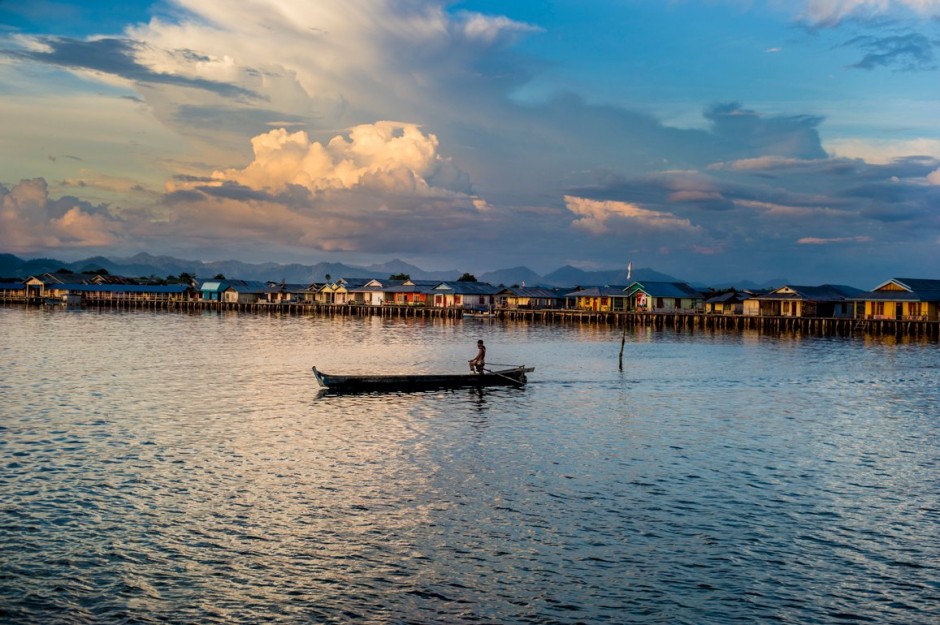
The Indonesian government has made a concerted effort to move the traditionally nomadic Bajau into settled communities on land. In Torosiaje, many Bajau left their government-provided homes and built this stilt village 1km out to sea. Basic amenities are scarce, however, and the poorest claim that government promises of help have been hollow, leading them to return to the old nomadic way of life at sea.
Photo: James Morgan
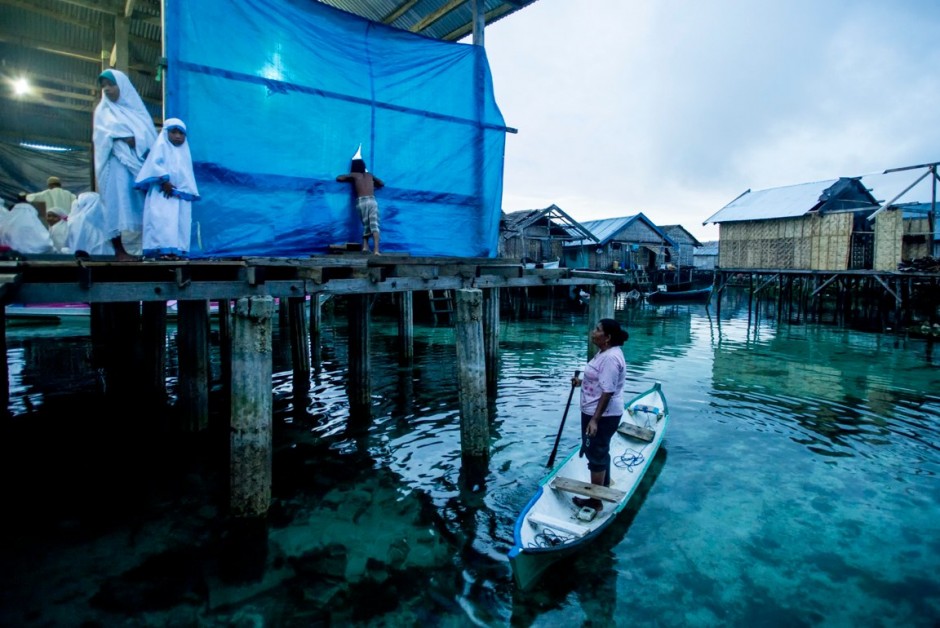
Despite the majority of Bajau now living in stilt communities and adopting cosmologies more in line with land-based communities, they still build their mosques over the ocean and practice a syncretic belief system that allows for a deep reverence for the ocean and the spirits that are said to inhabit it.
Photo: James Morgan
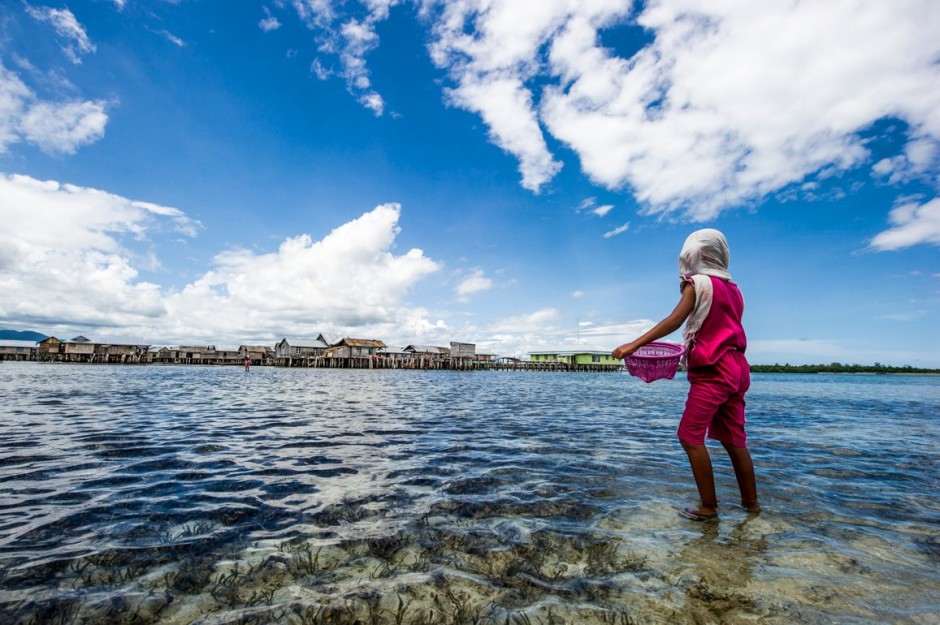
A young Bajau girl wades out from Torosiaje village to look for sea cucumbers and shellfish. The path to self-sufficiency begins at an early age, as children learn the vital skills of foraging in the shallows.
Photo: James Morgan
The origins of the Bajau diaspora are not entirely clear. Linguistic evidence seems to trace the ethnic group back to the 9th century in what is now the southern Philippines. As regional trade prospered under the wealthy Malay sultanates from the 15th century onwards, Bajau groups are thought to have migrated south in ever-larger numbers.
The Bajau themselves have a different way of explaining their dispersal, however. Legend tells of a princess from Johor, Malaysia, who was washed away in a flash flood. Her grief-stricken father ordered his subjects to depart the kingdom, returning only when they’d found his daughter. They’ve been wandering ever since.
Over generations, the Bajau adapted to their maritime environment, and though marginalised (so often the lot of the nomad), their knowledge was revered by the region’s powerful sultans, who counted on them to establish and protect new trade routes. Some are highly skilled freedivers, plunging to depths of 30m and more to hunt pelagic fish or search for pearls and sea cucumbers — a delicacy among the Bajau and a commodity they have traded for hundreds of years.
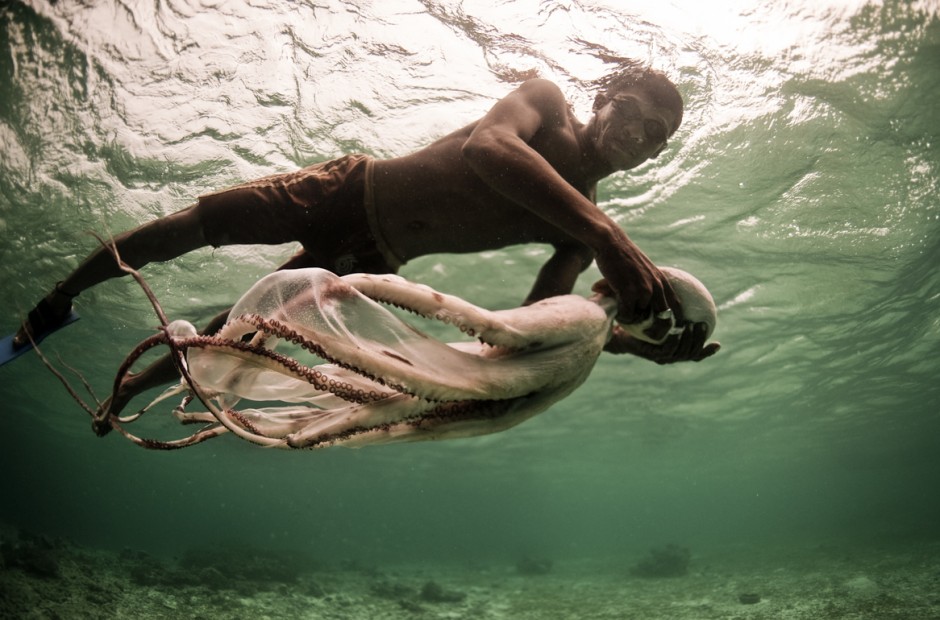
Jatmin, an octopus specialist, carries his freshly speared catch back to his boat in the shallow waters off the coast of Sulawesi, Indonesia.
Photo: James Morgan

Jatmin surfacing with an octopus.
The spearguns the Bajau often carry are handy for rooting the creatures from the holes in which they hide. Sulawesi, Indonesia.
Photo: James Morgan
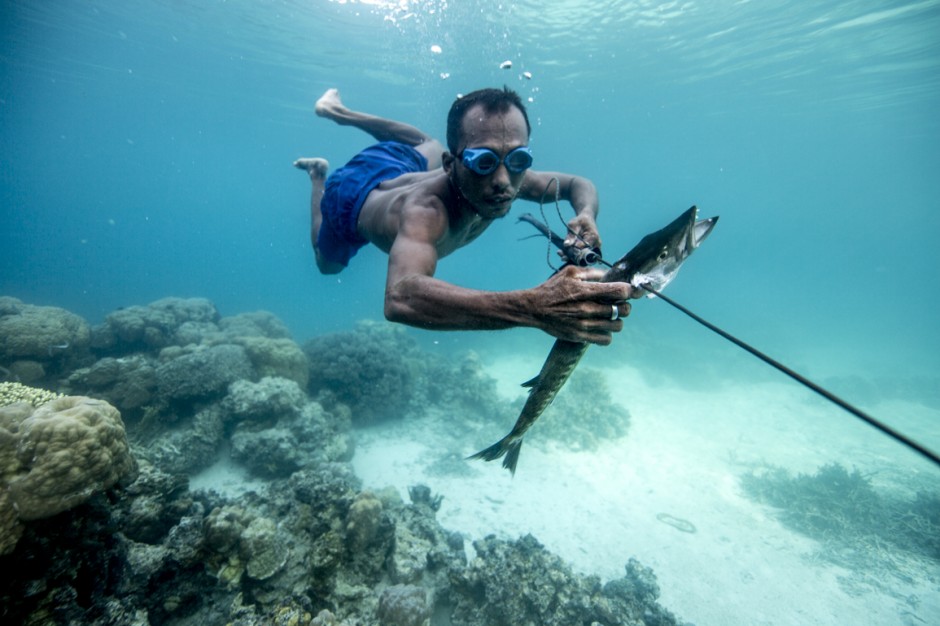
In addition to the nets and lines traditionally used for fishing, the Bajau use a handmade “pana” for spearing their catch.
Photo: James Morgan
Since diving is an everyday activity, the Bajau deliberately rupture their eardrums at an early age. “You bleed from your ears and nose and you have to spend a week lying down because of the dizziness,” said Imran Lahassan, our guide in Torosiaje. “But after that, you can dive without pain.” Unsurprisingly, most of the older Bajau are hard of hearing. A 40-year old with skin like mahogany and pale green eyes, Imran’s home was in Torosiaje Darat, the land-based part of the village. But like all Bajau, much of his life had been spent at sea. He told us about the original Bajau, who continued to live on their lepa lepa — narrow, high-prowed vessels that are highly prized amongst the region’s coastal populations.
“They come back to the village maybe every six months,” he explained.
We set off to find them, Imran’s nephew steering us expertly through the shallows, while Imran sat perched in the prow inspecting his handmade spear guns, or pana. Every man seemed to possess one or more of these, which they fashioned from boat timber, tyre rubber, and scrap metal. What their weapons lack in range and accuracy, the Bajau more than make up for in skill, as we were to witness.
We found what we were looking for just two hours out from Torosiaje, in the late afternoon; a cluster of boats sheltering in the lee of a small island beside a mangrove forest where the water was calm. By far the most talkative among them was Ane Kasim, who lived on her boat with her son, Ramdan, a boy of about 15 who was as silent as his mother was voluble. She told us that her husband had died, that she could not even afford a rudimentary engine for her boat, and that she would have to row her way back to Torosiaje when the time came. But when I asked her if she’d prefer to live in a house in the village, she shook her head emphatically. “I love being at sea…fishing, rowing…just feeling everything — the cold, the heat.”
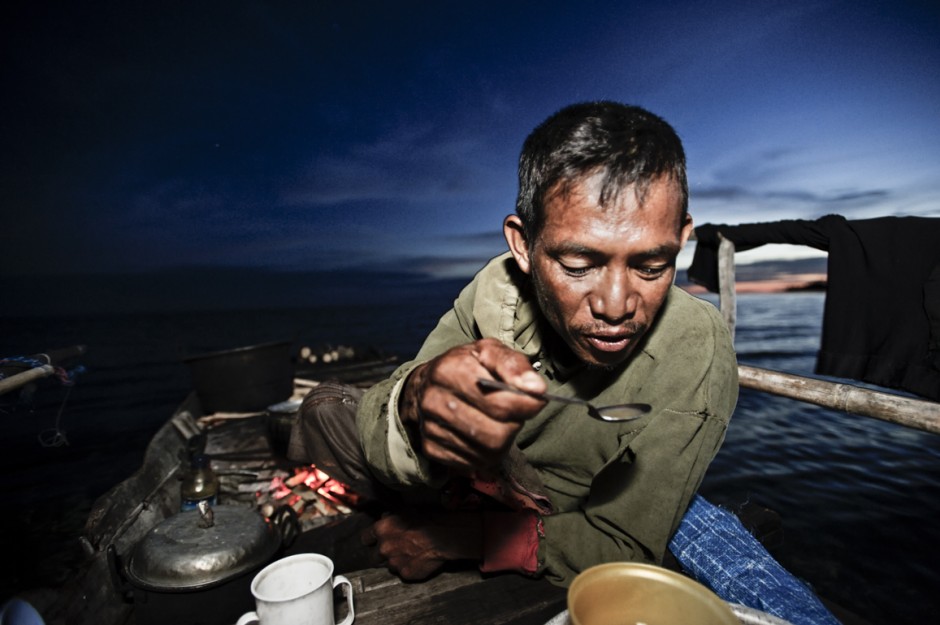
Amja Kasim Derise cooking dinner at home on his traditional lepa lepa boat.
The back of the boat is used for cooking, the middle for sleeping, and the front for fishing.
Photo: James Morgan
As dusk settled, the boats slowly converged and small fires were lit in the sterns. One man grilled crustaceans while another boiled a stew of sea cucumber; we were handed plastic mugs of lukewarm coffee and Ane sang folk songs, her plaintive keen the only sound to be heard other than the lapping of the water on the sides of the boats. They slept under the stars, curled on the wooden slats of their vessels with tarpaulins at the ready should it rain.
The next day, we encountered Moen Lanke harvesting clams with a tyre iron. He was sporting woollen gloves and the handmade wooden goggles fitted with glass that are ubiquitous among the Bajau and which are good to 30m and more. Weighted with the heavy tool, he didn’t dive so much as walk down the coral outcrops, taking slow motion strides like some sort of cartoon spaceman. And he’d stay down there for a minute and more, digging the coral away to get at the shellfish. It wasn’t quite the image we’d nurtured of the freediving Bajau, but a striking one nevertheless.
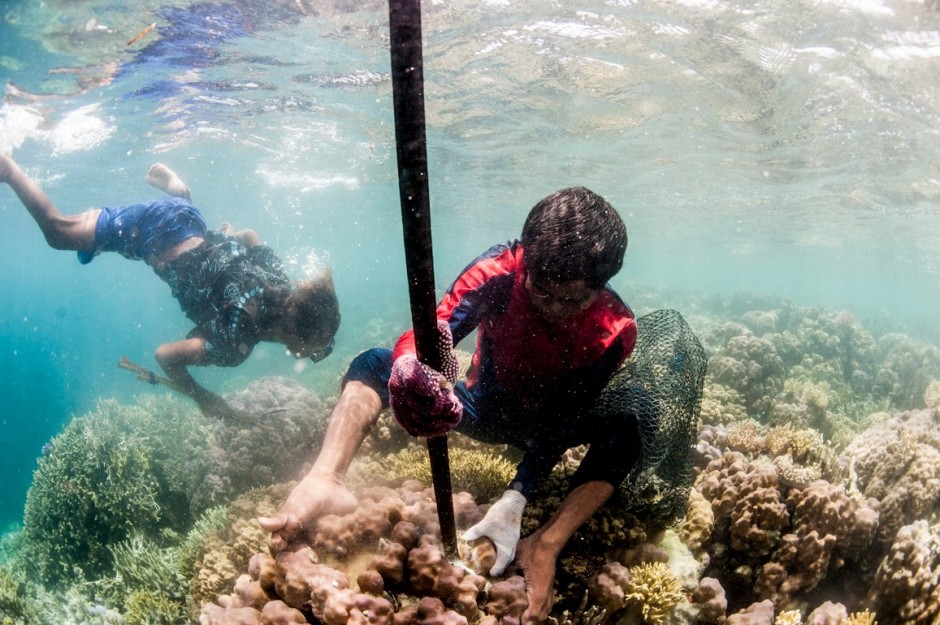
Moen Lanke wrenching clams from the reef with a tyre iron. He holds his breath for long minutes underwater while the work is done.
Photo: James Morgan
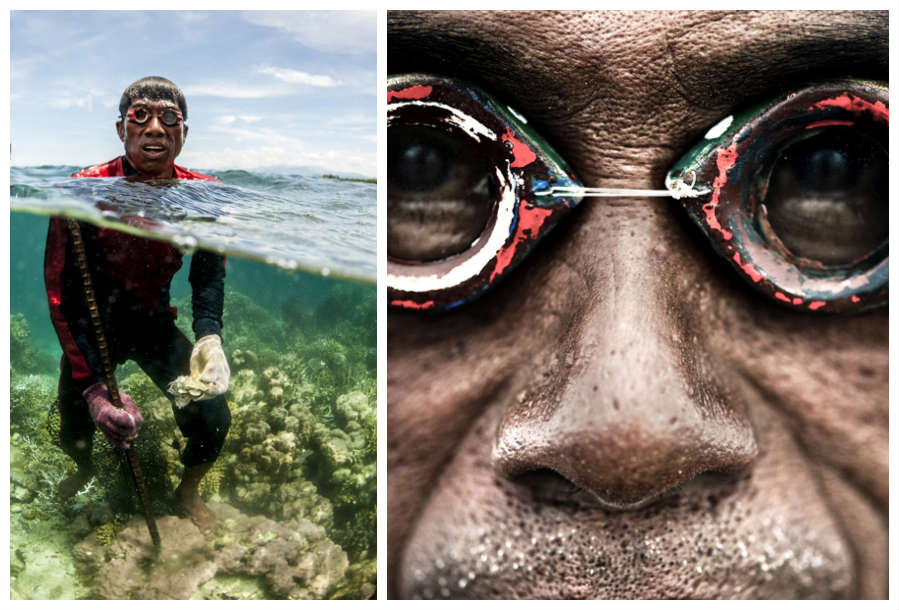
Moen Lanke, seconds after freediving for clams with a tyre iron. The weight of the iron holds him down on the ocean floor, allowing him to run along the reefs. In order to get around the problem of equalising (a technique used by scuba divers to balance the pressure of the inner and outer ear at depth), it is common practice amongst Bajau people to intentionally burst their ear drums at an early age.
Photos: James Morgan
Later, we saw some more conventional freediving. Siding Salihing, apparently a noted diver among the Torosiaje community, went deeper than we could follow, disappearing into the blue to return triumphant with a stuck octopus, which he proceeded to drape theatrically round his neck.
What we were witnessing was foraging — these people were subsisting on whatever they could harvest from the reefs, occasionally selling their meagre catch at local markets. Their lifestyle seemed to be driven as much by economic necessity as by the vital connection they had with the natural surroundings. Times had clearly changed.
“I used to be able to cast my net for 100sqm and fill it with fish,” Bada Epus, a fisherman from the nearby village of Lemito, told us. He gestured to his net. “This is one square kilometre and I barely catch anything.” Reclining in the back of his boat was his brother, Taha Epus. “He can’t walk,” Bada Epus told me abruptly. “He got cramp. But he can still dive well.”
By cramp, he’s referring to decompression sickness, or the bends. These days, those Bajau that can afford it dive using compressors. An onboard engine pumps air through a common garden hose so divers can go deeper for longer — 40m and more. Unaware of the need to restrict their exposure to pressure, countless Bajau have ended up crippled or killed by deadly nitrogen bubbles in their bloodstream.
The practice continues, however, because it’s lucrative — especially when potassium cyanide is involved. Cyanide fishing was first introduced in the Philippines by Hong Kong fishing boats looking for reef species like grouper and Napoleon wrasse to satisfy the rising demand for live fish among Chinese seafood restaurants. It quickly spread throughout the Coral Triangle — a bioregion that encompasses much of the Philippines, Malaysia, Indonesia, Papua New Guinea, the Solomon Islands, and Timor L’Este. The Coral Triangle is an underwater Amazon — home to the planet’s greatest diversity of marine species, including 76% of all known corals and more than 3,000 species of fish. Cyanide is by far the most efficient way of capturing predator reef species alive — divers use plastic bottles to puff poisonous clouds at target species, stunning them and damaging the coral habitat in the process. Today, the live fish industry is worth upwards of US$800 million a year, according to research by WWF.
And when it comes to destructive fishing practices, the Bajau have been some of the worst offenders, enthusiastically adopting both dynamite and cyanide. Torosiaje used to be flanked by teeming reefs; now there are only wastelands of broken coral, a legacy of years of dynamite and cyanide fishing. It’s a common story throughout the Coral Triangle — communities destroying the environment that sustains them, driven by voracious global markets.
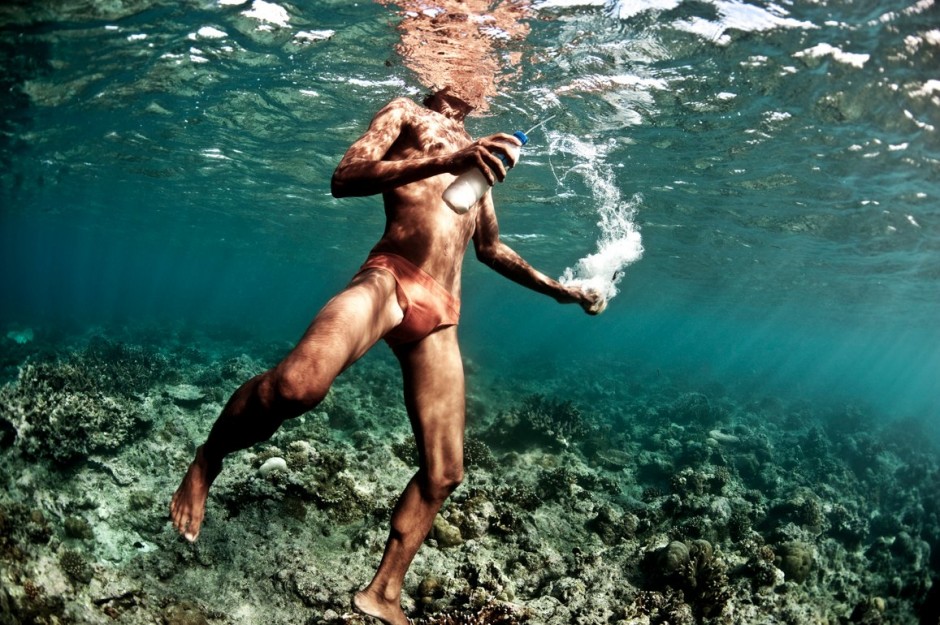
Compressor diving, often in conjunction with cyanide fishing, remains a common practice amongst the Bajau Laut despite being unsustainable, illegal, and highly dangerous. Young Bajau men, and often children, will routinely dive to depths of 60 metres with air pumped down to them through a hose pipe and a regulator. With no knowledge of the dangers inherent in diving to such depths, they often ascend far too quickly, resulting in nitrogen buildup and the bends. Compressor diving is one of the main causes of unnatural death amongst the Bajau communities I have visited.
Photo: James Morgan

Pak Usrin demonstrates how to make a fertiliser bomb. He assures me, however, that he stopped bombing reefs back in 2005. Today he gets paid through Reef Check Indonesia to protect his local coral environment.
Photo: James Morgan
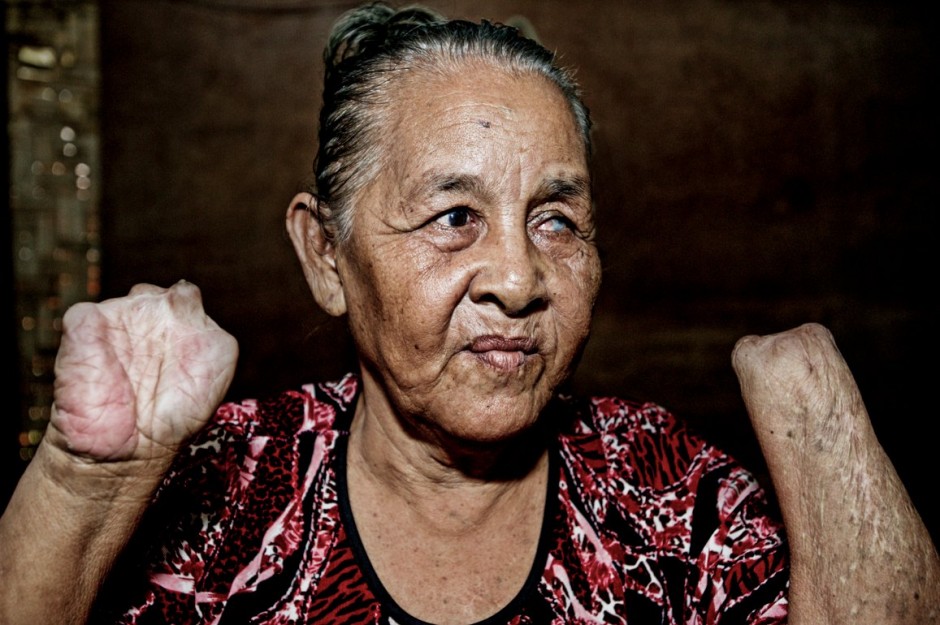
Ibu Hanisa lost her hands and the sight in one eye when a homemade fertiliser bomb went off in her house. There are human, as well as environmental, costs to destructive fishing practices.
Photo: James Morgan
Back in Torosiaje village, we are introduced to Sansang Pasangre, the resident dukun, or healer. He explains to us that the ocean is filled with penghuni lautan — djinn, or spirits, that can be called upon if their names are known. “They enter our bodies and speak through us, giving us knowledge and advice. There are only 10 people in the village who can do this, though,” he explains. The Bajau’s beliefs mean that when at sea, a complex system of taboos govern their behaviour, since every reef, tide, and current is thought of as a living entity. The disconnect is a glaring one: How does this sacred regard for the ocean tally with the destructive fishing that is so rife among the Bajau?
The truth was, our vision of the Bajau before we encountered them had been a romantic one, as though we expected them to occupy some rarefied space, traveling migratory routes, the natural stewards of their ocean environment. Decades ago perhaps. But the nomadic Bajau we met were desperately poor and marginalized; many felt betrayed by the Indonesian government, which they claimed had failed to provide promised support in terms of subsidies. “Look, my boat has no teeth, just like me,” says Fajar Botutihe, Diana’s husband. He gestures at a section of his boat where the wood has rotted, grinning to reveal blackened stumps, probably the legacy of a lifetime chewing pinang — the mildly narcotic nut that Malay peoples commonly combine with betel leaves. He may be laughing, but his boat is in a sorry state and he hasn’t got the Rp.12 million (US$1,300) to buy a new one. We’re on a tiny island; Fajar’s boat has been pulled ashore and he has lit a fire beneath the keel to kill parasites and algae.
From what we witnessed, the integrity of the Bajau belief system had been diluted as their mode of living had changed, with socioeconomic concerns superseding the cultural cohesion that would have been a prerequisite of their traditional nomadic lifestyle.
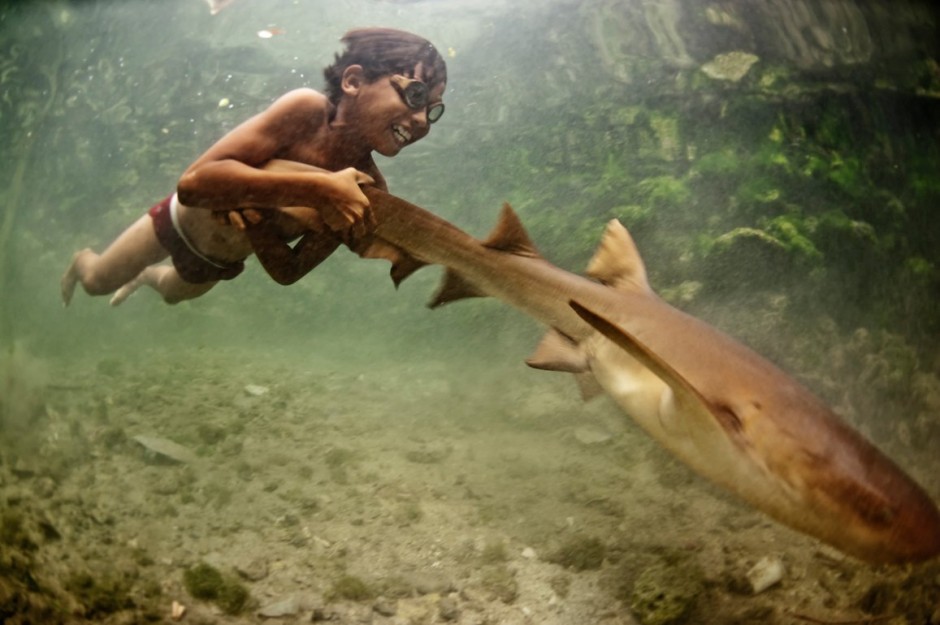
Whilst few young Bajau are now born on boats, the ocean is still very much their playground. Here Enal plays with his pet shark.
Photo: James Morgan
Traditional Bajau cosmology is a syncretism of animism and Sunni Islam, with a rich oral tradition of epic songs known as ikiko — sung in its entirety, an ikiko can take as long as two days to complete and is a deeply emotional experience for the community. These songs used to be an integral bind, performed at all major ceremonies. We found one old man still able to sing the ikiko, though he needed frequent rests. His grandson looked on anxiously. “It makes him sad,” he explains. “He’s remembering.”
The future of the Bajau remains uncertain. Cultural dissipation looks likely to continue, as they contend with a modern world of nation states that has little room for wanderers. Still, conservation charities like WWF and Conservation International are helping create marine management programmes that encourage sustainability through no-fish zones and a return to artisanal fishing methods. It is often Bajau that socialise such programmes to local communities, communicating key messages at a grassroots level. There are also efforts underway to increase the benefits from burgeoning tourism, particularly in Semporna. If nothing else, such grassroots programmes demonstrate that the Bajau’s reverence and knowledge of their marine environment could so easily be used to conserve rather than destroy.
Practicalities
When to go: The best time to visit Torosiaje is during the dry season between April and October.
How to get there: From Makassar in South Sulawesi, you can take a connecting flight to Gorontalo. Hire a car for around US$50 (4-5 hours), or else take a local bemo or minibus from the town centre (6-8 hours).
Hot tip: Spend a few nights in Gorontalo if you can and check out the world-class reefs, which include many fascinating endemic species, one of which, the so-called Salvador Dali Sponge, is found nowhere else in the world.
Further info: There is a very basic stilted homestay at the seaward end of the village, which costs around Rp.100,000 per person per night. Boats can be hired from local people — be prepared to negotiate on price. Expect to pay between US$30-US$50 per day, so it’s cheaper if you’re traveling as a group. It’s best to start by meeting with the kepala desa (village headman) when you arrive.
